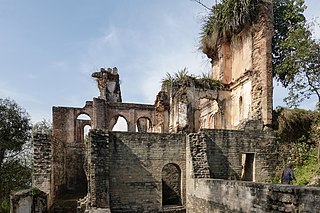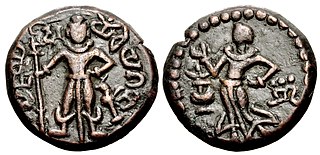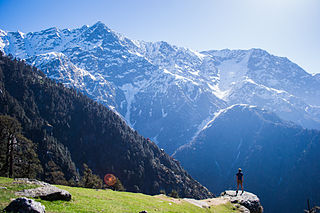
Punjab is a geopolitical, cultural, and historical region in South Asia. It is specifically located in the northwestern part of the Indian subcontinent, comprising areas of modern-day eastern-Pakistan and northwestern-India. Punjab's major cities are Lahore, Faisalabad, Rawalpindi, Gujranwala, Multan, Ludhiana, Amritsar, Sialkot, Chandigarh, Shimla, Jalandhar, Patiala, Gurugram, and Bahawalpur.

The Beas River is a river in north India. The river rises in the Himalayas in central Himachal Pradesh, India, and flows for some 470 kilometres (290 mi) to the Sutlej River in the Indian state of Punjab. Its total length is 470 kilometres (290 mi) and its drainage basin is 20,303 square kilometres (7,839 sq mi) large.

The History of Punjab refers to the past history of Punjab region which is a geopolitical, cultural, and historical region in the northwest of South Asia, comprising eastern Punjab province in Pakistan and western Punjab state in India. It is believed that the earliest evidence of human habitation in Punjab traces to the Soan valley of the Pothohar, between the Indus and the Jhelum rivers, where Soanian culture developed between 774,000 BC and 11,700 BC. This period goes back to the first interglacial period in the second Ice Age, from which remnants of stone and flint tools have been found.

Hamirpur district is in the Indian state of Himachal Pradesh. The headquarters of the district are in the town of Hamirpur. With an area of 1,118 square kilometres or 432 square miles, it is the smallest district of Himachal Pradesh.

The Kingdom of Kuninda was an ancient central Himalayan kingdom documented from around the 2nd century BCE to the 3rd century, located in the southern areas of modern Himachal Pradesh and far western areas of Uttarakhand in northern India and Doti Gadwall in Nepal.

Kangra-Lambagraon was a historical princely estate (jagir) of British India located in the present-day state of Himachal Pradesh.

The Audumbras, or Audumbaras (Hindi;ओदुम्बर) were a north Indian tribal nation east of the Punjab, in the Western Himalaya region. They were the most important tribe of the Himachal, and lived in the lower hills between Sirmaur, Chamba and Yamuna.

Pathankot is a city and the district headquarters of the Pathankot district in Punjab, India. Pathankot is the 6th most populous city of Punjab, after Ludhiana, Amritsar, Jalandhar, Patiala and Bathinda. Its local government is a municipal corporation.
Katoch is a Chandravanshi Rajput clan with unbroken bloodline established in 4300B.C. There areas of residence are mainly in the Indian states of Himachal Pradesh, Jammu, Punjab, and Uttarakhand. Traditionally resided in Kangra Fort, Trigarta Kingdom, Jalandhar, Multan.
Kekeya Kingdom was a kingdom mentioned in the ancient Indian epic Mahabharata among the western kingdoms of then India. The epic Ramayana mentions one of the wives of Dasharatha, the king of Kosala and father of Rama, was from Kekeya kingdom and was known as Kaikeyi. Her son Bharata conquered the neighbouring kingdom of Gandhara and built the city of Takshasila. Later the sons and descendants of Bharata ruled this region from Takshasila.

Yaudheya (Brahmi script: 𑀬𑁅𑀥𑁂𑀬) or Yoddheya Gana (Yoddheya Republic) was an ancient militant gana (confederation) based in the Eastern region of the Sapta Sindhu. The word Yaudheya is a derivative of the word from yodha meaning warriors and according to Pāṇini, the suffix '-ya', was significant of warrior tribes, which is supported by their resistance to invading empires such as the Kushan Empire and the Indo-Scythians. Rudradaman I of the Western Satraps notes in his Junagadh rock inscription that the Yaudheyas were 'heroes among all Kshatriya' and 'were loath to surrender'. They were noted as having a republic form of government, unique from other Janapadas which instead maintained monarchies.

The Kangra fort is a historic fort located in the Kangra district of the Himachal Pradesh state, India. This fort is also known as 'Nagarkot' and 'Kot Kangra'. This fort stands on a hillock between two rivers, among the foothills of the Dhauladhar range. This fort is the largest in the Indian Himalayas, and is under the protection of the Archeological Survey of India.
Prasthala was the capital of king Susharman of Trigarta Kingdom. As per the epic Mahabharata, this city was under the constant attack of Matsya kings like the king Virata. Susharman tried to avenge the Matsyas with the help of Duryodhana of Hastinapura, but the attempt was foiled by the Pandavas staying in the domains of the Matsyas. Prasthala is either identified to be the modern city Patiala in Punjab, India or Jalandhar in Punjab, India.

Himachal Pradesh was established in 1948 as a Chief Commissioner's Province within the Union of India. The province comprised the hill districts around Shimla and southern hill areas of the former Punjab region. Himachal became a part C state on 1951 with the implementation of the Constitution of India. Himachal Pradesh became a Union Territory on 1 November 1956. On 18 December 1970 the State of Himachal Pradesh Act was passed by Parliament and the new state came into being on 25 January 1971. Thus Himachal emerged as the eighteenth state of the Indian Union.

McLeod Ganj or McLeodganj is a suburb of Dharamshala in Kangra district, Himachal Pradesh, India. It is known as "Little Lhasa" or "Dhasa" as the Tibetan government-in-exile is headquartered here and there is a significant population of Tibetans in the region.
Raja Bhil Pal was a Rajput ruler of the kingdom of Nurpur, in the Himalayan foothills. He was a contemporary of Sikandar Lodi of Delhi (1488–1516), and assisted him in his wars and therefore increased his own territory.
Shamirpur is a town in the Kangra district of the Indian state of Himachal Pradesh. It is located next to National Highway 20, which runs from Pathankot in Punjab to Mandi in Himachal Pradesh. It is easily accessible from Dharmasala. The nearest airport is Gaggal Airport, alternatively known as Kangra Airport or Dharamsala-Kangra Airport, which is located in Gaggal near Kangra, 14 kilometres (8.7 mi) southwest of Dharamshala.

Nurpur kingdom in the Himalayan foothills of India was founded in 1064 A.D at north-eastern Bari Doab between the Ravi and the Beas rivers at the fusion of Kangra, Duggar, Majha, Dharab and Chamba areas which ended in 1815. The remnants of Nurpur kingdom exist as ruined forts, restored temples, water bodies, and canals in Nurpur tehsil, Fatehpur tehsil, Pathankot tehsil, Dhar Kalan tehsil, Jawali tehsil, Indora tehsil Bhattiyat tehsil, and Sihunta tehsil.
Kamlah Fort is a 17th-century fort located near Kamlah village in the province of Himachal Pradesh, India west of Mandi. It was probably constructed in 1625 by Raja Suraj Sen of Mandi.

Sankaravarman was a ruler of the Utpala dynasty, which ruled over the Kashmir region from 8th to 10th century CE. The kingdom was established by Avantivarman, who ended the rule of Karkota dynasty in 855 CE.













